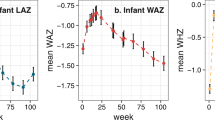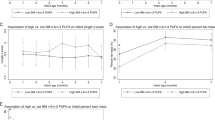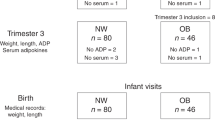Abstract
Background/Objectives
Limited research suggests that exposure to long-chain PUFAs (LCPUFAs) during perinatal development can influence adipose tissue expansion later in life. In previous analyses, we observed that maternal LCPUFAs in late gestation promote offspring gestational growth, whereas breast milk n-3 LCPUFAS promote adipogenesis in infants up to 1 year. This follow-up analysis examines these relationships in offspring up to 5 years.
Subjects/Methods
In this observational study of 169 children, relationships between n-3, n-6 LCPUFAs, and the n-6/n-3 LCPUFA ratio in maternal blood at 32 weeks’ gestation, cord blood, and breast milk, and anthropometry in offspring from 2 to 5 years were investigated. Body composition was assessed with indirect (i.e., body weight, BMI percentiles, sum of four skinfold thicknesses) and direct (i.e., ultrasonography, magnetic resonance imaging in a subgroup) measurement tools.
Results
Maternal and cord blood LCPUFAs were largely not shown to be related to offspring body composition. Breast milk n-3 LCPUFAs were significantly positively related to several measurements of child anthropometry at 2 and 4 y, but only a positive relationship between n-3 LCPUFAs and lean body mass remained statistically significant at 5 y. Breast milk n-6/n-3 LCPUFA ratio was inversely related to weight and BMI percentiles at 2 y, and lean body mass at 4 and 5 y.
Conclusions
Results from this follow-up do not provide sufficient evidence that LCPUFAs in maternal blood, cord blood, and breast milk predict offspring adiposity in children up to 5 years.
This is a preview of subscription content, access via your institution
Access options
Subscribe to this journal
Receive 12 print issues and online access
$259.00 per year
only $21.58 per issue
Buy this article
- Purchase on Springer Link
- Instant access to full article PDF
Prices may be subject to local taxes which are calculated during checkout
Similar content being viewed by others
References
Alfaradhi MZ, Ozanne SE. Developmental programming in response to maternal overnutrition. Front Genet. 2011;2:27.
Gluckman PD, Hanson MA, Cooper C, Thornburg KL. Effect of in utero and early-life conditions on adult health and disease. New Engl J Med. 2008;359:61–73.
Innis SM. Essential fatty acid transfer and fetal development. Placenta. 2005;26:S70–5.
Ailhaud G, Guesnet P. Fatty acid composition of fats is an early determinant of childhood obesity: a short review and an opinion. Obes Rev. 2004;5:21–6.
Ailhaud G, Guesnet P, Cunnane SC. An emerging risk factor for obesity: does disequilibrium of polyunsaturated fatty acid metabolism contribute to excessive adipose tissue development? Br J Nutr. 2008;100:461–70.
Hauner H, Vollhardt C, Schneider KT, Zimmermann A, Schuster T, Amann-Gassner U. The impact of nutritional fatty acids during pregnancy and lactation on early human adipose tissue development. Rationale and design of the INFAT study. Ann Nutr Metab. 2009;54:97–103.
Rodriguez G, Iglesia I, Bel-Serrat S, Moreno LA. Effect of n-3 long chain polyunsaturated fatty acids during the perinatal period on later body composition. Br J Nutr. 2012;107:S117–28.
Lapillonne A, Carlson SE. Polyunsaturated fatty acids and infant growth. Lipids. 2001;36:901–11.
Martinez-Victoria E, Yago MD. Omega 3 polyunsaturated fatty acids and body weight. Br J Nutr. 2012;107:S107–16.
Wood K, Mantzioris E, Lingwood B, Couper J, Makrides M, Gibson RA, et al. The effect of maternal DHA supplementation on body fat mass in children at 7 years: follow-up of the DOMInO randomized controlled trial. Prostaglandins Leukot Essent Fatty Acids. 2018;139:49–54.
Muhlhausler BS, Yelland LN, McDermott R, Tapsell L, McPhee A, Gibson RA, et al. DHA supplementation during pregnancy does not reduce BMI or body fat mass in children: follow-up of the DHA to Optimize Mother Infant Outcome randomized controlled trial. Am J Clin Nutr. 2016;103:1489–96.
Hauner H, Much D, Vollhardt C, Brunner S, Schmid D, Sedlmeier EM, et al. Effect of reducing the n-6:n-3 long-chain PUFA ratio during pregnancy and lactation on infant adipose tissue growth within the first year of life: an open-label randomized controlled trial. Am J Clin Nutr. 2012;95:383–94.
Brei C, Stecher L, Much D, Karla MT, Amann-Gassner U, Shen J, et al. Reduction of the n-6:n-3 long-chain PUFA ratio during pregnancy and lactation on offspring body composition: follow-up results from a randomized controlled trial up to 5 y of age. Am J Clin Nutr. 2016;103:1472–81.
Donahue SM, Rifas-Shiman SL, Gold DR, Jouni ZE, Gillman MW, Oken E. Prenatal fatty acid status and child adiposity at age 3y: results from a US pregnancy cohor. t Am J Clin Nutr. 2011;93:780–8.
Moon RJ, Harvey NC, Robinson SM, Ntani G, Davies JH, Inskip HM, et al. Maternal plasma polyunsaturated fatty acid status in late pregnancy is associated with offspring body composition in childhood. J Clin Endocrinol Metab. 2013;98:299–307.
Standl M, Thiering E, Demmelmair H, Koletzko B, Heinrich J. Age-dependent effects of cord blood long-chain PUFA composition on BMI during the first 10 years of life. Br J Nutr. 2014;111:1–8.
Much D, Brunner S, Vollhardt C, Schmid D, Sedlmeier EM, Bruderl M, et al. Effect of dietary intervention to reduce the n-6/n-3 fatty acid ratio on maternal and fetal fatty acid profile and its relation to offspring growth and body composition at 1 year of age. Eur J Clin Nutr. 2013;67:282–8.
Much D, Brunner S, Vollhardt C, Schmid D, Sedlmeier EM, Bruderl M, et al. Breast milk fatty acid profile in relation to infant growth and body composition: results from the INFAT study. Pediatr Res. 2013;74:230–7.
Brei C, Much D, Heimberg E, Schulte V, Brunner S, Stecher L, et al. Sonographic assessment of abdominal fat distribution during the first year of infancy. Pediatr Res. 2015;78:342–50.
Deutsche Gesellschaft für Ernährung. Wie ernähre ich mich in Schwangerschaft und Stillzeit? (German Nutrition Society. Booklet on Healthy Eating during Pregnancy and Breastfeeding.) Cited March 2011.
Weststrate J, Deurenberg P. Body composition in children: proposal for a method for calculating body fat percentage from total body density or skinfold thickness measurements. Am J Clin Nutr. 1989;50:1104–5.
Kromeyer-Hauschild K, Wabitsch M, Kunze D, Geller F, Geiß H, Hesse V, et al. Percentiles of body mass index in children and adolescents evaluated from different regional German studies. Mon Kinderheilkd. 2001;8:807–19.
Horan M, Gibney E, Molloy E, McAuliffe F. Methodologies to assess paediatric adiposity. Ir J Med Sci. 2015;184:53–68.
Beermann C, Mobius M, Winterling N, Schmitt JJ, Boehm G. sn-position determination of phospholipid-linked fatty acids derived from erythrocytes by liquid chromatography electrospray ionization ion-trap mass spectrometry. Lipids. 2005;40:211–8.
Lepage G, Roy CC. Improved recovery of fatty acid through direct transesterification without prior extraction or purification. J Lipid Res. 1984;25:1391–6.
Hakola L, Takkinen HM, Niinisto S, Ahonen S, Erlund I, Rautanen J, et al. Maternal fatty acid intake during pregnancy and the development of childhood overweight: a birth cohort study. Pediatr Obes. 2017;12:26–37.
Rolland-Cachera MF, Deheeger M, Maillot M, Bellisle F. Early adiposity rebound: causes and consequences for obesity in children and adults. Int J Obes (Lond). 2006;30:S11–7.
Koletzko B, Braun M. Arachidonic acid and early human growth: is there a relation? Ann Nutr Metab. 1991;35:128–31.
Lauritzen L, Hoppe C, Straarup EM, Michaelsen KF. Maternal fish oil supplementation in lactation and growth during the first 2.5years of life. Pediatr Res. 2005;58:235–42.
Delgado-Noguera MF, Calvache JA, Bonfill Cosp X, Kotanidou EP, Galli-Tsinopoulou A. Supplementation with long chain polyunsaturated fatty acids (LCPUFA) to breastfeeding mothers for improving child growth and development. Cochrane Database Syst Rev. 2015;7:Cd007901.
Asserhoj M, Nehammer S, Matthiessen J, Michaelsen KF, Lauritzen L. Maternal fish oil supplementation during lactation may adversely affect long-term blood pressure, energy intake, and physical activity of 7-year-old boys. J Nutr. 2009;139:298–304.
Acknowledgements
We are grateful to the parents and children who participated in the INFAT study.
Funding information
Supported by grants from the Else Kröner-Fresenius Foundation, Bad Homburg; the International Unilever Foundation, Hamburg; the European Union-funded Early Nutrition Programming Project (EARNEST) consortium (FOOD-CT-2005-007036); the German Ministry of Education and Research via the Competence Network Obesity (Kompetenznetz Adipositas, 01GI0842); and Danone Research-Centre for Specialized Nutrition, Friedrichsdorf, Germany.
Author information
Authors and Affiliations
Corresponding author
Ethics declarations
Conflict of interest
The authors declare no conflict of interest.
Additional information
Publisher’s note: Springer Nature remains neutral with regard to jurisdictional claims in published maps and institutional affiliations.
Rights and permissions
About this article
Cite this article
Meyer, D.M., Brei, C., Stecher, L. et al. Associations between long-chain PUFAs in maternal blood, cord blood, and breast milk and offspring body composition up to 5 years: follow-up from the INFAT study. Eur J Clin Nutr 73, 458–464 (2019). https://doi.org/10.1038/s41430-018-0388-3
Received:
Revised:
Accepted:
Published:
Issue Date:
DOI: https://doi.org/10.1038/s41430-018-0388-3
This article is cited by
-
Maternal childhood trauma is associated with offspring body size during the first year of life
Scientific Reports (2022)
-
Fetal sex modulates placental microRNA expression, potential microRNA-mRNA interactions, and levels of amino acid transporter expression and substrates: INFAT study subpopulation analysis of n-3 LCPUFA intervention during pregnancy and associations with offspring body composition
BMC Molecular and Cell Biology (2021)



